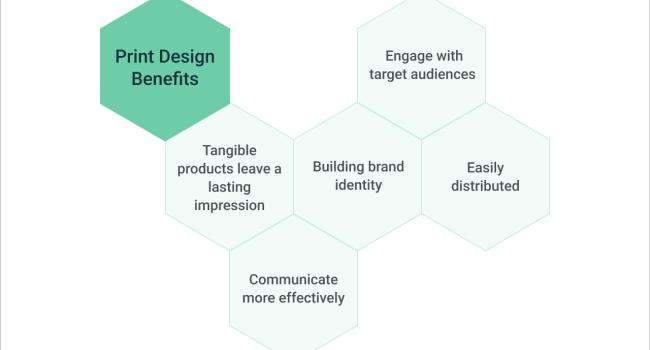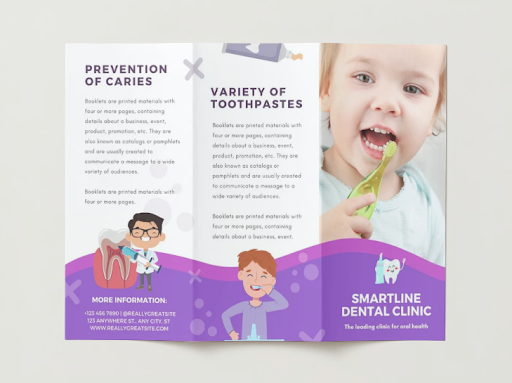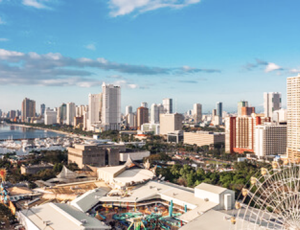Updated December 1, 2025
Print design marries visual aesthetics with tactile experiences, creating communications that are not only seen but felt. The benefits of print design are plentiful, ranging from the tangible nature of printed materials, which engages more senses than digital media, to the credibility and authority it can lend to a brand.
Unlike digital alternatives, print materials such as brochures, business cards, and posters occupy physical space, offering a permanence that can fortify the presence of a brand in the minds of its audience. In a landscape inundated with fleeting digital interactions, print design stands out by offering a memorable and immersive experience.
Print design companies can help you create publications, marketing collateral, and advertising materials that stand out and leave lasting impressions for your target audiences.
This guide dives into everything you need to know about print design so you can begin searching for a print design company to support your business’s design needs.
What is Print Design?
Print Design: Print design includes the design and creation of print materials such as pamphlets, posters, fact sheets, and cards. Designers focus on graphic design elements, typography, and imagery to convey a message or information while maintaining a company’s brand and visual identity across all print materials.
Print materials allow businesses to showcase their brand identity, products, and services in a tangible and more memorable way. One of the key benefits of print design is its ability to leave a lasting impression on the audience.
Unlike digital media, print designs can be physically held, creating a sense of credibility and authenticity. Because of this, print design is an effective marketing tool for building brand recognition and establishing a strong visual presence in the market.
In order to create effective materials to support your business goals, print design teams spend time gathering information from their clients. Background information like company branding, market research, audience, and project goals can help them create a cohesive look and feel across all of your materials.
For this reason, the print design process is multifaceted and can include:
- Conceptualizing and sketching
- Digital design
- Branding design
- Review and iteration
- Proofing
- Printing
With a solid understanding of design concepts like layout design, typography, and color theory, print design companies are able to deliver high-quality designs that can help you reach specific design goals.
Whether you’re hoping to capture the attention of new audiences, educate readers, or grow brand awareness, hiring a print design company can help achieve your goals.
Print Design Services by Country
Print Design Services by City
5 Benefits of Print Design Services
Companies hire print designers to create many different kinds of materials. While a client’s primary goals may vary, a print design team can combine their artistic creativity with technical skills to deliver visually appealing and impactful designs regardless of the format.

Here are some of the most prominent reasons why companies choose to invest in print design and hire print design companies for their work:
- Tangible products leave a lasting impression. As discussed above, tangible materials engage audiences more effectively than digital materials. Because people are able to touch it and reference it many times, print materials are more memorable than other media forms.
- Building brand identity and recognition. Visually-appealing print materials can help businesses convey key information while reinforcing their brand identity. Print designers will use brand colors, fonts, and imagery to ensure that the materials they create accurately reflect what your business is all about. With additional exposure to your brand, audiences are more likely to recall it and recognize it in the future.
- Engage with target audiences. Print design allows for targeted distribution of materials to specific demographics or locations, ensuring that the message reaches the intended audience effectively. As mentioned above, print materials can easily be referenced over and over, allowing audiences to engage more with your brand.
- Easily distributed. By producing high-quality content that can be easily distributed, companies can connect with a broader audience. Flyers, brochures, and pamphlets, for example, can provide a wealth of information and can easily be passed from one person to the next.
- Communicate messages more effectively. Great print designers use visual hierarchy, color theory, imagery, and more to ensure that your message is used effectively. Whether you’re trying to spread awareness for an upcoming event, explain your service offerings, or provide valuable information about healthcare, a print design company can ensure that viewers understand your key points after a quick scan of the materials they create.
What Goes Into Print Design?
While you look at print materials, you clearly see text and a few pictures, but a lot more goes into the design than you may expect. To create a cohesive design that includes all of the information you need to convey, print designers are involved with nearly every detail that impacts the look of the final product. This can include:
- Formatting
- Layout design
- Margin size
- Font
- Typography
- Kerning
- Font size for headings, subheading, and body text
- Images
- Image size to ensure they are still high-quality
- Infographics
- Colors
- Icons
Without paying attention to specific details like this, your materials would be difficult to read and not very visually appealing. Combining these elements, print designers ensure that your message is conveyed well.
What Services Do Print Design Companies Offer?
As discussed above, print design refers to the design and creation of many different types of print materials. The format and material you choose depends largely on the goals of your project. After all, some formats are better suited for conveying information than others.
Whichever format you decide is best for your project, print design companies are able to organize information so it fits on the page, is still easy to read, and is still visually appealing.

Here are some of the materials that print design companies are able to design and create:
- Newsletters
- Annual reports
- Brochures
- Pamphlets
- Business cards
- Magazine & Book Covers
- Flyers
Newsletters
Newsletters are commonly used by businesses, organizations, and individuals to engage with their audience, share valuable content, and promote products or services. Similar to digital newsletters, print newsletters can foster community building, increase engagement, and keep your brand top of mind.
Newsletters usually contain articles, images, news stories, announcements, and more. Especially if you plan to release a newsletter regularly, print design companies can ensure that your newsletter has a cohesive look and feel across all publications.
Annual Reports
An annual report is a comprehensive document that provides an overview of a company's activities and financial performance throughout the preceding year. It typically includes financial statements, management discussions and analysis, market performance, corporate governance, and other pertinent information.
Annual reports are crucial for shareholders, investors, and other stakeholders as they offer insights into the company's operations and financial health. Because they’re being shared with important stakeholders and contain important information, many companies rely on print designers to make sure the report is organized well and is easy to consume.
Additionally, annual reports need to include visual elements — like graphs and charts — to effectively communicate the company's achievements, challenges, and future aspirations. Print designers can ensure that these design elements look good and support the report.
Brochures
Many businesses share brochures at trade shows, add them to in-store displays, use them for direct mail campaigns, and other marketing initiatives to provide potential customers with detailed information about a business offering.
Brochures are typically printed on a single sheet of paper that's folded into two or three sections, creating multiple panels for content. They contain a combination of text and images to effectively convey key messages and features to the target audience.
Because there is very limited room in a brochure, print designers ensure that information is organized well so that readers quickly understand key points quickly.
For example, many universities provide brochures so prospective students can learn more about the school. They often contain information like location, student population size, popular programs, and tuition costs.

Prospective students can then quickly refer to the brochure when they are deciding whether or not to attend the school.
Pamphlets
Similar to brochures, Pamphlets are concise and typically consist of a single sheet of paper, often folded into panels. They are commonly used for promotional or educational purposes, providing a brief overview of a particular topic, cause, event, or product.
Many businesses distribute pamphlets by hand at large events or display them in racks for easy access. They can serve as effective tools for raising awareness, conveying key messages, and engaging with a target audience.
You often see pamphlets in doctors offices or dental offices as a resource for patients. These pamphlets provide information on how to stay healthy, medications, and procedures.

For example, dentists could use a pamphlet like this to provide information on how cavities form, how to practice good dental hygiene, and provide information on new products like toothpaste.
Business Cards
Business cards are an important networking and branding tool. Business cards allow professionals to quickly exchange contact information during networking events, conferences, or chance encounters, making it easier for individuals to stay in touch.
Many businesses also ask print designers to design their business cards because they represent the business and its brand. Business cards often feature a company's logo, colors, and design elements.

Well-designed business cards convey a sense of professionalism and preparedness, which can enhance credibility and trustworthiness.
Magazine & Book Covers
Publishing magazines and books can enhance a company's brand by showcasing expertise, thought leadership, and industry knowledge, thus increasing brand awareness and credibility. They serve as powerful content marketing tools, allowing businesses to engage their audience with valuable, in-depth content related to their business.
A skilled print designer can create visually stunning and impactful covers for books and magazines. Eye-catching designs can capture the attention of potential readers and stand out on newsstands or in digital formats.
Flyers
Flyers are single-page leaflets and are typically printed on one or both sides. Usually, companies distribute them in high-traffic areas to attract attention and convey a specific message to a target audience. Flyers often include eye-catching visuals, concise text, contact information, and a call to action.
Businesses and organizations use flyers for various purposes, such as promoting sales, announcing events, raising awareness for causes, advertising new products or services, and providing essential information about a business or event. Due to their cost-effectiveness and versatility, flyers are a popular marketing tool for reaching a local or targeted audience.
What is a Print Design Team?
Depending on the scope of your project, you can hire either independent print designers or coordinate with full print design companies.
While both are able to create high-quality designs for whatever your business requires, print design companies tend to have more resources, allowing them to deliver more designs on a faster timeline. Freelancers, on the other hand, can be more affordable and may be a better fit if you have a smaller project.
If you’re looking for extensive print design services and choose to hire a full print design team, here are some of the people you will be working with:
Who Makes Up A Print Design Team?
- Creative Director: Creative directors are responsible for leading and managing the entire print design team. They ensure that all designs reflect your vision, brand, and goals. They play a crucial role in setting the artistic direction and maintaining the creative integrity of your project.
- Graphic Designers: Graphic designers are focused on the visual aspects of print design. They will create the layout design, typography design, color schemes, and more.
- Project Managers: Project managers communicate between the client and the rest of the design team. They play a crucial role coordinating the project to make sure everything is delivered on time, in-budget, and to the client’s satisfaction.
- Brand Managers: Branding is a big component of print design, so having a branding expert on the team can ensure that all of your print materials communicate your company’s message and values effectively.
What to Look For When Hiring Print Design Services
In addition to one-off projects, many companies hire print design teams for long-term partnerships. This can create consistency across all of their materials, especially if they plan to invest more in out-of-home (OOH) advertising and other marketing strategies.
If you are going to invest in these strategies, though, finding a print design partner that can effectively deliver the materials you want while sticking to your timeline and budget is absolutely necessary.
While priorities differ from company to company, many use the same criteria when evaluating potential service providers. Factors like their style, the services they offer, pricing, and client ratings can help you select a partner for your project.
Criteria for Hiring a Print Design Company
- Style
- Services offered
- Accessible printers
- Budget
- Location
- High client ratings
Client ratings and reviews can help you understand what it’s like to work with each service provider. Insights like how they communicate, their ability to make deadlines, and how satisfied their clients are with their work can help you find the best fit for your business.
What Matters to You Most?
As you learn more about each print design company, you will start to narrow down your search. As discussed above, priorities vary from team to team, but what’s most important to you? Affordability? Creative Style? Robust service offerings?
Determining what you value most can help you develop criteria for selecting a print design partner. With this information, you can reach out to vendors, set up interviews, and begin shortlisting potential providers.
In addition to getting a better understanding of the services they offer, the interview process is an opportunity to discuss the scope of your project, price, and communication style so you can narrow down your list even further.
Here are a few questions you should ask when interviewing print design companies:
10 Questions to Ask When Hiring Print Design Services
- Can you provide examples of your previous work?
- Have you worked with others in our industry?
- Are you also able to print materials yourself or do you partner with a printing company?
- What is your design process like?
- How do you collaborate with clients?
- How do you handle revisions or changes to the design?
- What is your turnaround time for projects?
- Do you have any testimonials or references from past clients?
- What software and tools do you use for graphic design?
- What is your pricing structure? Are there any additional costs?
How to Assess The Performance of Print Design Services
It can be challenging to assess the performance of print design services because it is an exceptionally creative field. However, you still need to be able to measure the impact of the partnership on your business. For this reason, it’s important to establish objective key results (OKRs) and identify key performance indicators (KPIs) and the beginning of your partnership.
The most important benchmark is subjective — do you like their print designs? After all, this project is about delivering assets that can support your business goals, whether that is to grow brand awareness through flyers, update stakeholders with well-designed reports, or strengthen credibility with business cards.
When considering their design work, think about whether or not their designs follow brand guidelines, how effectively they communicate key points, and whether or not they were able to incorporate feedback from your team when necessary.
You should also consider how seamless your partnership was. Did they deliver everything on time? Did you have to go through several iterations? How seamless was communication with them?
While a great print design team is able to take your vision and bring it to life, they should also be easy to collaborate with and reliable.
How Print Design Services Can Improve Your Brand Image & Marketing Materials
Print design is a facet of design that focuses on delivering tangible materials for all of your business needs. Whether you’re looking for new business cards, signage, brochures, or anything else, it’s important that all of your materials reflect your brand and effectively communicate your message.
While the services they offer, their style, and your budget are likely the most important things to consider when hiring a print designer, you should also consider the ease of working with them. Collaborative print design companies communicate exceptionally well, which can ensure a positive experience and that deliverables meet all objectives.
Whether you’re looking to hire a print design company for a one-off project or are hoping to facilitate a long-term partnership, Clutch can help you refine your search and find the right partner for your project.















